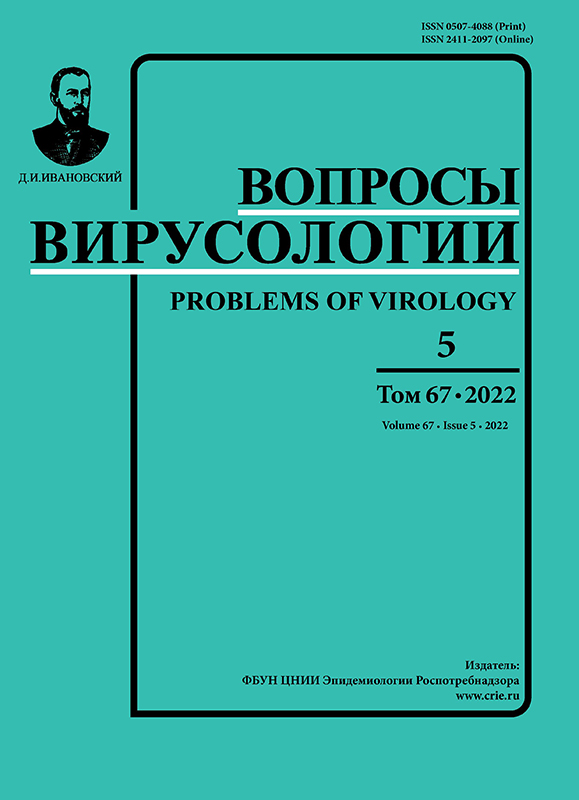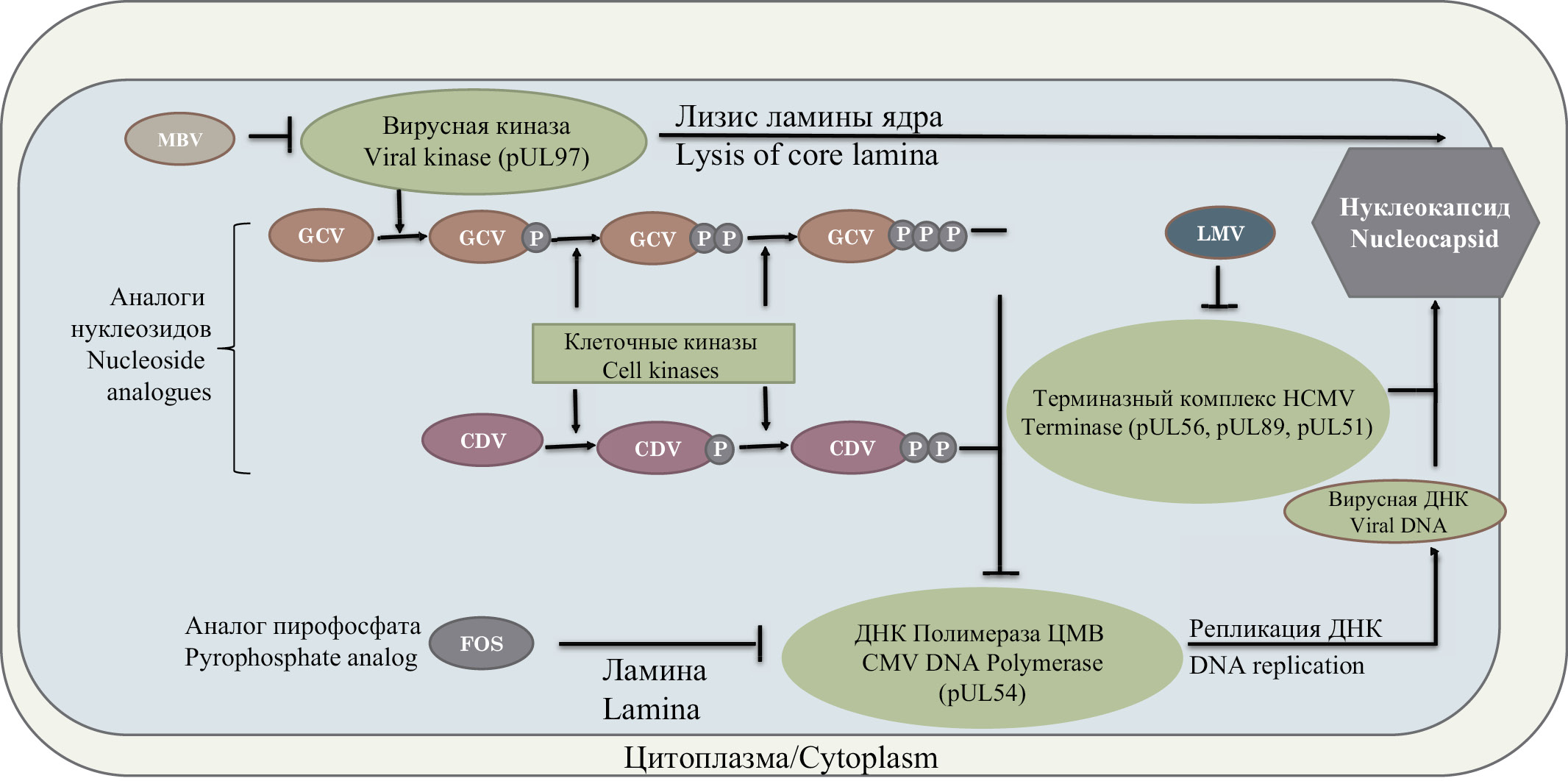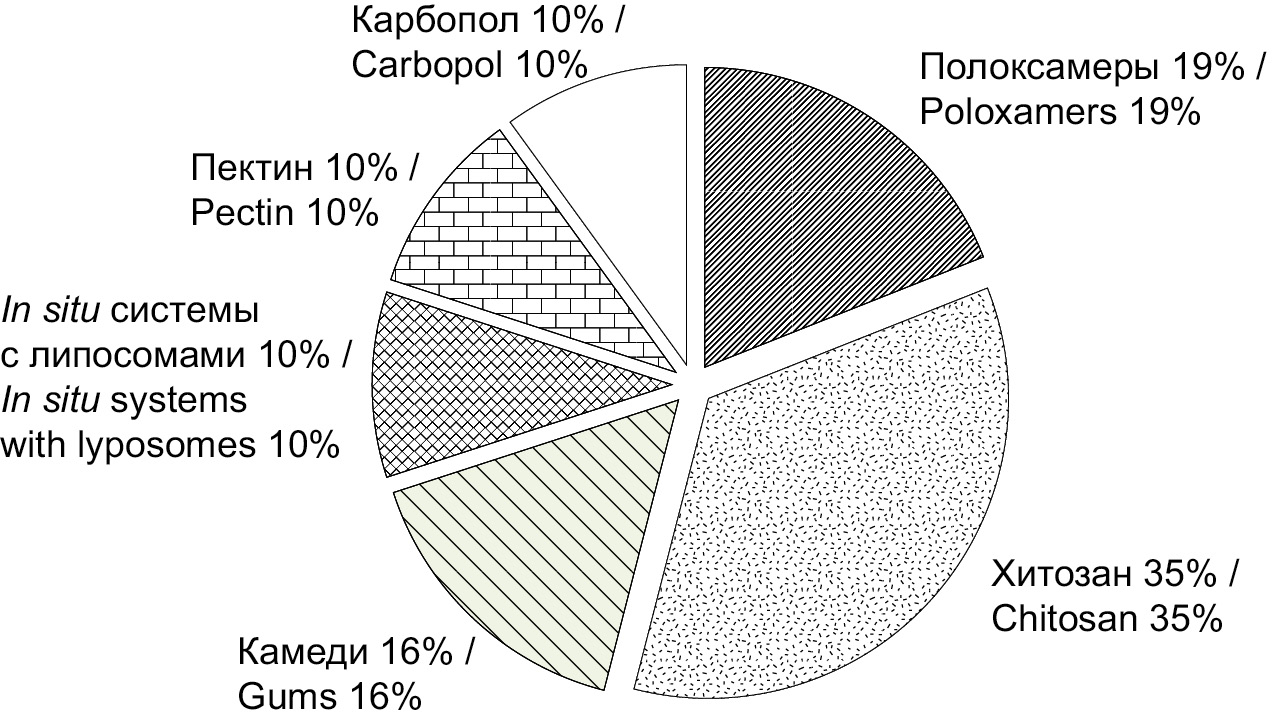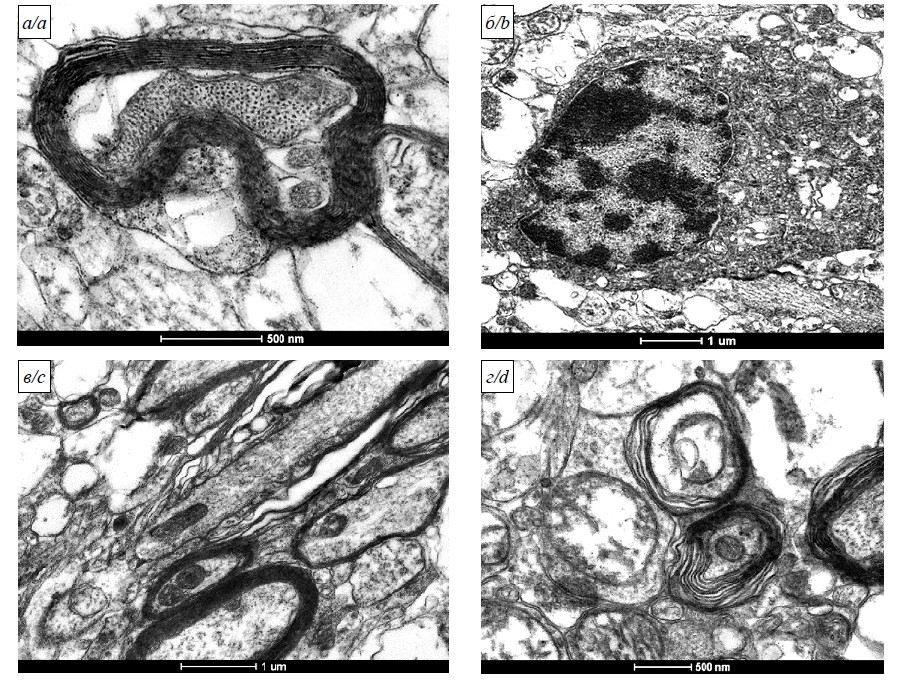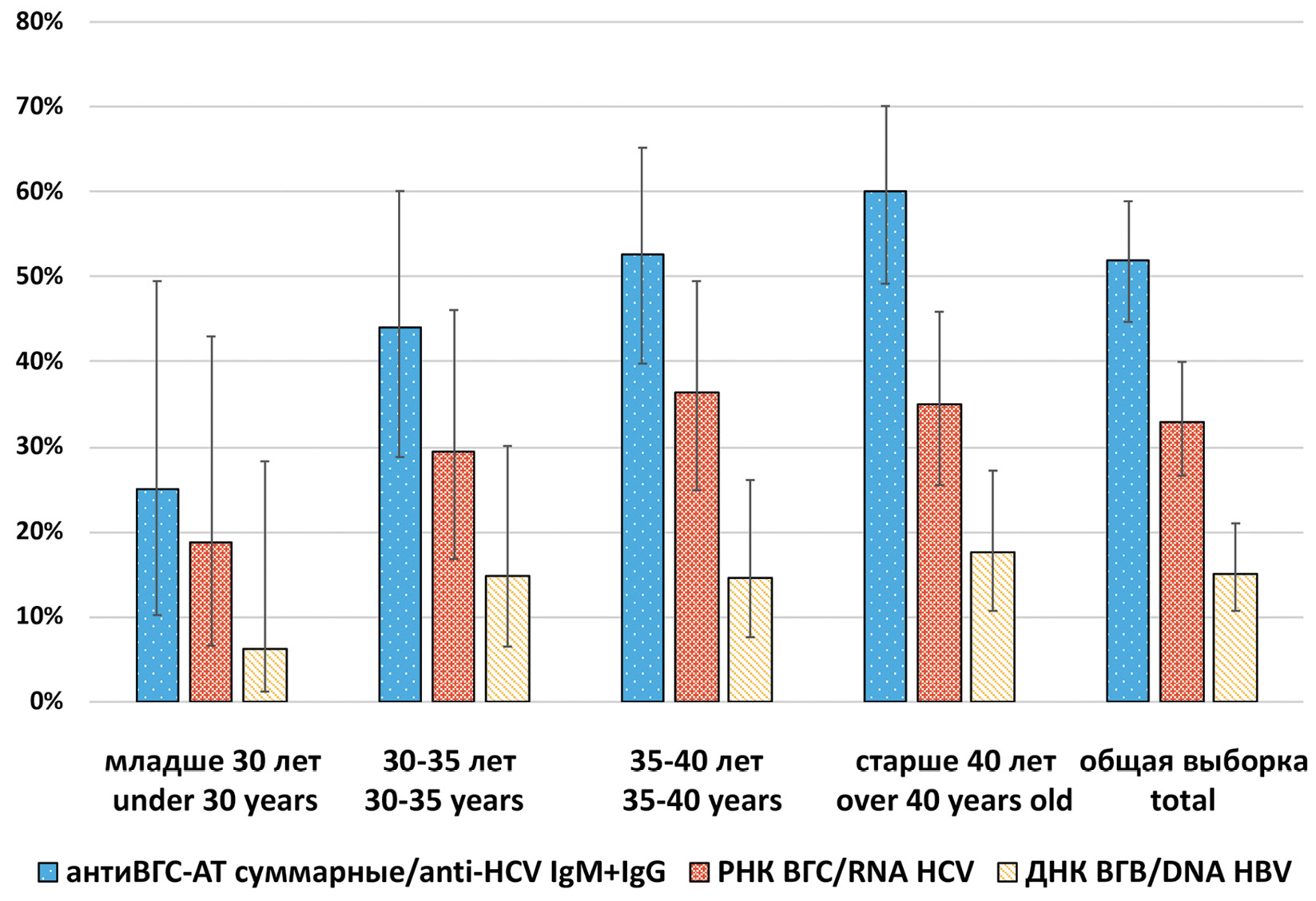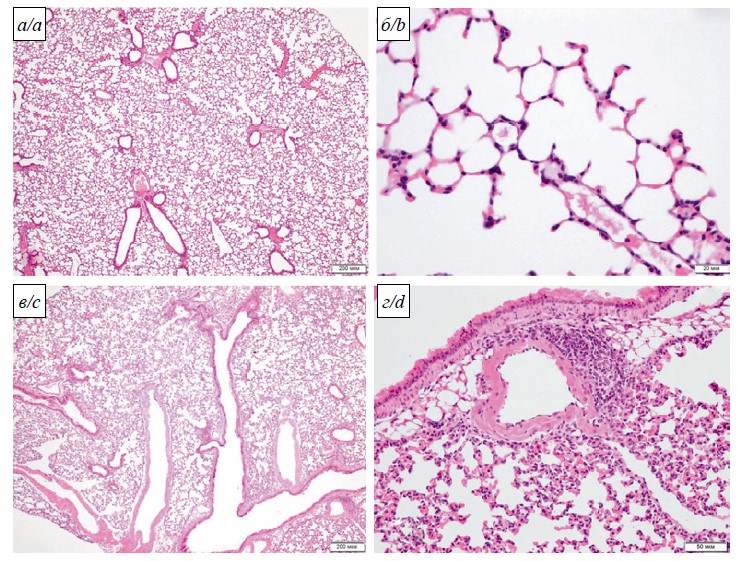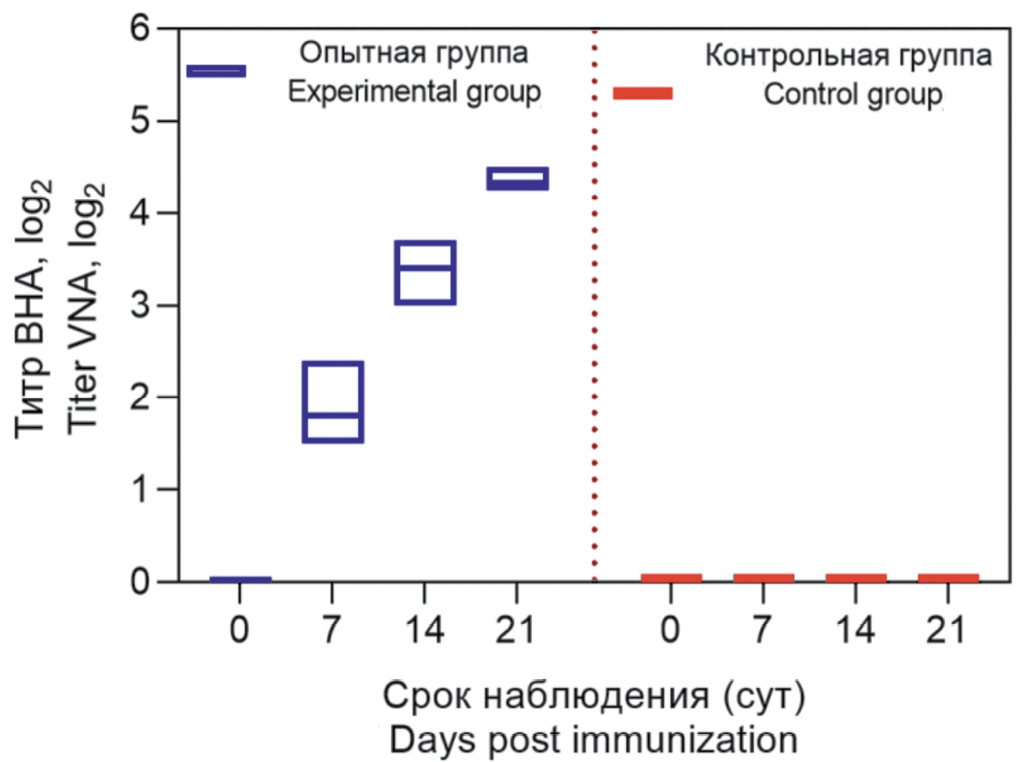Том 67, № 5 (2022)
- Год: 2022
- Выпуск опубликован: 19.11.2022
- Статей: 8
- URL: https://virusjour.crie.ru/jour/issue/view/58
Весь выпуск
ОБЗОРЫ
Устойчивость к противовирусным препаратам у вирусов человека из подсемейства Betaherpesvirinae
Аннотация
В обзоре представлена информация о механизмах возникновения устойчивости к противовирусным препаратам у вирусов человека из подсемейства Betaherpesvirinae. Даны сведения о принципах работы противовирусных препаратов и их характеристика. Описана частота появления вирусной устойчивости у различных групп пациентов и показаны сведения о возможных последствиях возникновения устойчивости к противовирусным препаратам. Дана информация о генах вируса, в которых происходят мутации, приводящие к вирусной устойчивости, и список таких мутаций, описанных на данный момент. Обсуждается значение исследования мутаций, приводящих к устойчивости вируса к противовирусным препаратам, для медицинской практики.
 385-394
385-394


In situ гели как современный способ интраназальной доставки вакцин
Аннотация
Непрерывное появление новых патогенов и эволюция устойчивости микроорганизмов к препаратам делают абсолютно необходимой разработку инновационных эффективных стратегий вакцинации. Использование назальной вакцинации может повысить удобство и безопасность, вызвать как местные, так и системные иммунные реакции. Интраназальное введение тем не менее обладает рядом проблем, решение которых возможно с использованием последних достижений фармацевтической науки. Одним из аспектов может быть использование для производства интраназальных вакцин in situ систем – полимерных композиций, обеспечивающих направленный, контролируемый физиологическими условиями носовой полости переход «золь – гель». При этом гелеобразование вводимой дозы при соприкосновении со слизистой носовой полости предполагает длительную экспозицию лекарства на месте введения, большую мукоадгезию, противодействие мукоцилиарному клиренсу, модифицированное и более полное высвобождение. Такие полимеры, как хитозан, камеди, блок-сополимеры полиоксиэтилен и полиоксипропилен (полоксамеры, проксанолы), карбомеры, выпускаются рядом как иностранных, так и отечественных производителей. Для эффективного проведения фармацевтической разработки новых интраназальных систем доставки ИБП, соответствующих концепции QbD, необходимы не только знания ассортимента вспомогательных веществ, но и простые, доступные, воспроизводимые методики определения показателей критических параметров подобных систем доставки. В соответствии с проведённым научным поиском были выделены основные показатели стандартизации in situ интраназальных систем: температура и время гелеобразования, прочность геля, реологические характеристики, мукоадгезия, высвобождение, время назального мукоцилиарного клиренса.
 395-402
395-402


ОРИГИНАЛЬНЫЕ ИССЛЕДОВАНИЯ
Электронно-микроскопическое исследование неокортекса сирийских хомяков (Mesocricetus auratus) при инфекции вируса SARS-CoV-2 (Coronaviridae: Coronavirinae: Betacoronavirus: Sarbecovirus)
Аннотация
Введение. У пациентов, перенёсших COVID-19, выявляют признаки поражения центральной нервной системы, в том числе непосредственно ассоциированные с вирусом SARS-CoV-2. В связи с этим особую актуальность приобретают морфологические исследования изменений, вызываемых SARS-CoV-2, в коре головного мозга для изучения механизмов их формирования и разработки подходов к доклинической оценке эффективности противовирусных лекарственных средств.
Цель работы – изучение динамики ультраструктурных изменений в неокортексе сирийских хомяков после заражения вирусом SARS-CoV-2.
Материалы и методы. Самцов сирийских хомяков массой тела 80–100 г в возрасте 4–6 недель интраназально заражали 26 мкл культуры SARS-CoV-2 с концентрацией вирусных частиц 4×104 ТЦД50/мл. Эвтаназию выполняли на 3-и, 7-е или 28-е сутки после заражения, мозг извлекали с иссечением коры. Исследование материала проводили методом трансмиссионной электронной микроскопии.
Результаты и обсуждение. Установлено, что через трое суток после заражения в неокортексе возрастает количество умеренно гиперхромных нейронов, тогда как к 7-м суткам значимо увеличивается количество апоптотических клеток. В эти же сроки нарастают признаки нейронофагии и представительство атипичной глии. На 28-е сутки после заражения животных возрастает количество деструктивно изменённых олигодендроцитов. Показано, что вирусная инвазия уже на 3-и сутки после заражения сопряжена с конформационными изменениями клеток неокортекса – преобразованиями ядра, шероховатого эндоплазматического ретикулума и аппарата Гольджи, а также со спазмом микрососудов в сочетании с отёком периваскулярного пространства.
Заключение. В результате электронно-микроскопического исследования описаны ультраструктурные изменения неокортекса на экспериментальной модели инфекции SARS-CoV-2. Полученные данные могут быть применены для изучения патогенеза инфекции и поиска направлений разработки новых лекарственных средств.
 403-413
403-413


Анализ качества комбинированной отечественной вакцины для профилактики кори, краснухи и паротита
Аннотация
Введение. Поддержание высокого уровня охвата населения вакцинацией против кори, краснухи и паротита в условиях увеличения риска вспышек заболеваемости вследствие нарушения тактики вакцинопрофилактики в связи с пандемией коронавирусной инфекции и неблагоприятной эпидемической обстановкой в сопредельных странах обусловливает целесообразность применения комбинированного препарата для одновременной профилактики трёх социально значимых инфекций.
Цель исследования. Анализ качества коммерческих серий новой отечественной комбинированной вакцины против кори, краснухи и паротита культуральной живой (ККП) за всё время её выпуска по всем показателям спецификации нормативной документации.
Материалы и методы. Объектом исследования была комбинированная вакцина ККП. Анализ качества препарата производился по 86 сводным протоколам производства выпущенных серий, а также по результатам контроля этих серий в Испытательном центре экспертизы качества ФГБУ «Научный центр экспертизы средств медицинского применения Минздрава России.
Результаты. Показано, что качество комбинированного препарата для профилактики кори, краснухи и паротита соответствует нормативной документации по всем изученным показателям. Препарат не содержит антибиотик. Бычий сывороточный альбумин, являющийся технологической примесью, выявляется в количествах, более чем в 5 раз ниже установленной нормы. Сравнение специфической активности вирусных компонентов новой комбинированной вакцины и компонентов дивакцины против кори и паротита, произведённой предприятием в 2019–2021 гг., показало, что разброс значений активности вирусных компонентов в новом препарате и в сериях паротитно-коревой вакцины был минимален, что позволило сделать вывод о стабильности технологии производства.
Заключение. Качество новой отечественной комбинированной вакцины для профилактики кори, краснухи и паротита соответствует требованиям ВОЗ. Результаты проведённых исследований свидетельствуют о стабильности производства и стандартности качества препарата. Использование комбинированной вакцины против трёх актуальных инфекций обеспечит необходимый уровень охвата вакцинацией населения. Информация о результатах исследований может способствовать снижению количества отказов от вакцинации.
 414-422
414-422


Распространённость и молекулярно-генетическая характеристика вирусов парентеральных гепатитов B, C и D у ВИЧ-позитивных лиц в Новосибирской области
Аннотация
Введение. Вирусы парентеральных гепатитов B, C, D (ВГВ, ВГС, ВГD) и иммунодефицита человека (ВИЧ) характеризуются сходными путями передачи и группами риска, в которых повышена вероятность приобретения одновременно сразу двух и более из этих инфекций. Взаимное усугубление течения вирусных инфекций является важной проблемой, возникающей при коинфицировании ВИЧ-положительных пациентов парентеральными вирусными гепатитами.
Цель работы. Определение встречаемости и молекулярно-эпидемиологической характеристики генетических вариантов ВГВ, ВГС и ВГD, выявленных среди ВИЧ-положительных пациентов в Новосибирской области.
Материалы и методы. В 185 исследуемых пробах определяли наличие суммарных антител к ВГС, РНК ВГС, ДНК ВГВ и РНК ВГD. Положительные образцы генотипировали путём амплификации фрагмента гена NS5b для изолятов ВГС, гена pol для изолятов ВГВ и полногеномной последовательности для изолятов ВГD.
Результаты. Среди 185 исследуемых образцов суммарные антитела к ВГС были обнаружены в 51,9% (95% ДИ 44,7–58,9), РНК ВГС – в 32,9% (95% ДИ 26,6–39,5). Распределение генетического материала ВГС в различных половозрастных группах полностью повторяло распределение серологических маркеров. Инфицирование ВГС у ВИЧ-позитивных лиц имеет тенденцию к увеличению с возрастом. Распределение субгенотипов в изучаемой выборке изолятов ВГС имеет следующие особенности: 1b – 52,5%, 3а – 34,5%, 1а – 11,5%, 2а – 1,5%. 84,3% изолятов ВГС субгенотипа 1b имеют мутацию C316N, ассоциируемую с развитием резистентности к лечению софосбувиром и дацабувиром. Встречаемость ДНК ВГВ в исследуемых пробах составила 15,2% (95% ДИ 10,7–21,0). В одном изоляте ВГВ определена мутация M204I, связанная с устойчивостью к лечению ламивудином и телбивудином. Среди ВИЧ-/ВГВ-инфицированных пациентов обнаружено 2 изолята ВГD, относящихся к генотипу 1.
Заключение. Полученные данные подтверждают факт более широкого распространения инфицирования парентеральными вирусными гепатитами среди ВИЧ-позитивных лиц Новосибирской области по сравнению с условно здоровым населением. Генетическое разнообразие вариантов этих вирусов среди ВИЧ-инфицированных аналогично разнообразию, наблюдаемому в общей популяции.
 423-438
423-438


Сравнительное изучение Ухань-подобного и омикрон-подобного вариантов SARS-CoV-2 на экспериментальных животных моделях
Аннотация
Введение. Изменчивость SARS-CoV-2 оказалась выше ожидаемой, а появление новых вариантов вызывает обеспокоенность об их потенциально более высокой вирулентности, трансмиссивности, способности уклоняться от иммунных реакций, вызванных предыдущей инфекцией или вакцинацией. В связи с этим важно изучение патогенеза таких вариантов на экспериментальных моделях SARS-CoV-2.
Цель работы – сравнение патогенности вариантов Ухань и BA.1.1 (омикрон) у мышей BALB/c и сирийских хомяков.
Материал и методы. В исследовании использованы штаммы SARS-CoV-2 Dubrovka, филогенетически близкий к штамму Wuhan-Hu-1, и LIA, филогенетически близкий к штамму омикрон, мыши BALB/c, трансгенные мыши B6.Cg-Tg(K18-ACE2)2Prlmn/HEMI Hemizygous for Tg(K18-ACE2)2Prlmn, сирийские золотистые хомяки. Заражение животных проводили интраназально, определение вирулентности выполняли посредством комплекса клинических, патоморфологических и вирусологических методов.
Результаты. Сравнительные исследования штаммов SARS-CoV-2 Dubrovka (Ухань-подобного) и LIA (омикрон-подобного) на моделях животных продемонстрировали их различную патогенность. При параллельном заражении мышей BALB/c вариантами Dubrovka и LIA инфекция протекала без серьёзных клинических признаков и повреждений лёгких. Заражение штаммом LIA приводило к системному заболеванию с высоким содержанием вирусной РНК в лёгких и тканях мозга животных. Вирусная РНК у мышей при заражении штаммом Dubrovka была преходящей и не обнаруживалась в лёгких уже на 7-й день после заражения. Напротив, у хомяков штамм Dubrovka обладал большей патогенностью, чем штамм LIA. При инфицировании штаммом Dubrovka поражения лёгких были значительнее, наблюдались потеря массы тела и распространение вируса по органам, в частности в ткани головного мозга, в то время как при заражении штаммом LIA вирус в тканях головного мозга не определялся.
Заключение. Изучение различных вариантов SARS-CoV-2 у видов, изначально невосприимчивых к инфекции, важно для мониторинга зоонозных резервуаров, создающих риск распространения новых вариантов у людей.
 439-449
439-449


В ПОМОЩЬ ВИРУСОЛОГУ
Адаптация вируса оспы овец (Poxviridae: Capripoxvirus: Sheeppox virus) к линии клеток почки африканской зелёной мартышки и оценка его иммунобиологических свойств
Аннотация
Введение. Вспышки инфекционных заболеваний серьёзно препятствуют сохранению и увеличению поголовья мелкого рогатого скота. К числу таких инфекций относится оспа овец. По данным Всемирной организации здравоохранения животных, в 2021 г. вспышки были зарегистрированы в таких странах, как Турция, Израиль, Китай, Мальдивы, Монголия, Таиланд, Россия, Алжир, Кения, а в 2019 г. в Мангистауской и Атырауской областях Казахстана. С целью предотвращения проникновения инфекции из соседних стран в республике ежегодно проводится плановая иммунизация овец группы риска живой аттенуированной вакциной производства Научно-исследовательского института проблем биологической безопасности.
Материалы и методы. Объектами исследования являлись вакцинный штамм НИСХИ и вирулентный штамм А вируса оспы овец. Система культивирования вируса – культура клеток Vero. Для определения безвредности и иммуногенности использовали овец казахской тонкорунной породы в возрасте от 6 до 12 мес. При исследовании применяли вирусологические, серологические и иммунобиологические методы.
Результаты. Приведены результаты исследования по адаптации штамма НИСХИ вируса оспы овец к перевиваемой линии клеток Vero. Пятикратное пассирование на перевиваемой линии клеток Vero привело к адаптации штамма НИСХИ с проявлением цитопатогенного эффекта, специфичного для вируса оспы овец, с титром 6,50 lg ТЦД50/мл. При тестировании на овцах адаптированный к перевиваемой линии клеток Vero испытуемый штамм оказался для них безвредным и на 7-е сутки после иммунизации стимулировал формирование иммунитета против оспы овец у животных со средним значением защитного титра 1,8 log2, которое увеличилось на 21-е сутки до 4,33 log2.
Заключение. Установлено, что штамм НИСХИ вируса оспы овец сохраняет свои вирусологические и иммунобиологические свойства при репродукции в перевиваемой линии клеток Vero.
 450-458
450-458


РЕДАКЦИОННАЯ КОНЦЕПЦИЯ
130 лет вирусологии
Аннотация
130 лет назад, в 1892 г., нашим великим соотечественником Дмитрием Иосифовичем Ивановским (1864–1920) открыт новый вид патогенов – вирусы. Вирусы существуют с момента зарождения жизни на Земле и на протяжении более 3 млрд лет по мере эволюции биосферы включены в межпопуляционные взаимодействия с представителями всех царств жизни: архей, бактерий, простейших, водорослей, грибов, растений, беспозвоночных и позвоночных животных, позднее включая вид Homo sapiens (Hominidae, Homininae).
Открытие Д.И. Ивановского положило начало новой науке – вирусологии, бурное развитие которой в XX в. было связано с борьбой с новыми и возвращающимися (emerging-reemerging) инфекциями, эпидемии (эпизоотии) и пандемии (панзоотии) которых создавали угрозу национальной и глобальной биобезопасности (клещевой и другие энцефалиты, геморрагические лихорадки, грипп, оспа, полиомиелит, ВИЧ, парентеральные гепатиты, коронавирусные и другие инфекции). Фундаментальные исследования свойств вирусов заложили основу для разработки эффективных методов диагностики, вакцинопрофилактики и противовирусных лечебных препаратов. Отечественные вирусологи продолжают занимать ведущие позиции по некоторым приоритетным направлениям современной вирусологии, в частности по вакцинологии, мониторингу формирования популяционного генофонда вирусов в процессе эволюции в различных экосистемах и ряду других направлений. Осмысленное сочетание теоретических подходов изучения эволюции вирусов с инновационными методами исследований их молекулярно-генетических свойств и создание на этой основе новых поколений вакцин и противовирусных препаратов обеспечат существенное снижение последствий грядущих пандемий (панзоотий), возможность возникновения которых в будущем чрезвычайно высока. В обзоре представлены основные этапы становления и развития вирусологии как науки в России с акцентом на наиболее значимых достижениях отечественных вирусологов в борьбе с вирусными инфекционными заболеваниями человека и животных.
 357-384
357-384









